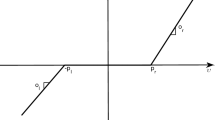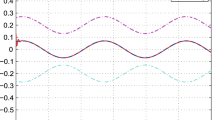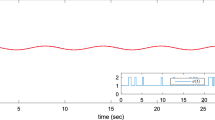Abstract
This paper presents a novel adaptive finite-time tracking control scheme for nonlinear systems. During the design process of control scheme, dead-zone input nonlinearity phenomena existing in the actuator is taken into account. Fuzzy logic systems are adopted to approximate the unknown nonlinear functions. This paper provides a new finite-time stability criterion, making the adaptive tracking control scheme more suitable in the practice than traditional methods. Under the presented controller, the desired system performance is realized in finite time. Finally, the validity and effectiveness of the proposed control method is validated by two examples.
Similar content being viewed by others
References
Y. M. Li, S. C. Tong, L. Liu, and G. Feng, “Adaptive output-feedback control design with prescribed performance for switched nonlinear systems,” Automatica, vol. 80, pp. 225–231, 2017.
F. Wang, X. Y. Zhang, B. Chen, C. Lin, X. H. Li, and J. Zhang, “Adaptive finite-time tracking control of switched nonlinear systems,” Inf. Sci., vol. 421, pp. 126–135, 2017.
F. Wang, B. Chen, C. Lin, J. Zhang, and X. Meng, “Adaptive neural network finite-time output feedback control of quantized nonlinear systems,” IEEE Trans. Cybern., vol. 48, no. 6, pp. 1839–1848, 2017.
Y. Yu and Y. S. Zhong, “Semiglobal robust backstepping output tracking for strict-feedback form systems with nonlinear uncertainty,” Int. J. Control Autom. Syst., vol. 9, no. 2, pp. 366–375, 2011.
Y. M. Li, L. Liu, and G. Feng, “A robust adaptive output feedback control approach to a class of non-triangular stochastic nonlinear systems,” Automatica, vol. 89, pp. 325–332, 2018.
X. Zhang, X. Liu, and Y. Li, “Adaptive fuzzy tracking control for nonlinear strict-feedback systems with unmodeled dynamics via backstepping technique,” Neurocomputing, vol. 235, pp. 182–191, 2017.
S. C. Tong, Y. M. Li, and S. Sui, “Adaptive fuzzy tracking control design for SISO uncertain non-strict feedback nonlinear systems,” IEEE Trans. Fuzzy Syst., vol. 24, no. 6, pp. 1441–1454, 2016.
Y. J. Liu, M. Z. Gong, S. C. Tong, C. L. P. Chen, and D. J. Li, “Adaptive fuzzy output feedback control for a class of nonlinear systems with full state constraints,” IEEE Trans. Fuzzy Syst., 2018.
Q. Zhou, H. Li, L. Wang, and R. Lu, “Prescribed performance observer-based adaptive fuzzy control for nonstrictfeedback stochastic nonlinear systems,” IEEE Trans. Syst. Man, Cybern. B, Cybern., vol. PP, no. 99, pp. 1–12, 2017.
L. Wang, M. Basin, H. Li, and R. Lu, “Observer-based composite adaptive fuzzy control for nonstrict-feedback systems with actuator failures,” IEEE Trans. Fuzzy Syst., vol. 26, no. 4, pp. 2338–2347, 2017.
Z. Tang, J. H. Park, and T. H. lee, “Dynamic outputfeedback-based H¥ design for networked control systems with multipath packet dropouts,” Appl. Math Comput., vol. 275, pp. 121–133, 2016.
C. D. Li, J. L. Gao, J. Q. Yi, and G. Q. Zhang, “Analysis and design of functionally weighted single-Input-Rule-Modules connected fuzzy inference systems,” IEEE Trans. Fuzzy Syst., vol. 26 no. 1, pp. 56–71, 2018.
C. D. Li, Z. X. Ding, D. B. Zhao, J. Q. Yi, and G. Q. Zhang, “Building energy consumption prediction: an extreme deep learning approach,” Energies, vol. 10, no. 10, pp. 1–20, 2017.
Y. M. Li, and S. C. Tong, “Fuzzy adaptive control design strategy of nonlinear switched large-scale systems,” IEEE Trans. Syst., Man, Cybern., Syst., vol. PP, no. 99, pp. 1–11, 2017.
Y. M. Li and S. C. Tong, “Adaptive neural networks prescribed performance control design for switched interconnected uncertain nonlinear systems,” IEEE Trans. Neural Netw. Learn. Syst., vol. 29, no. 7, pp. 3059–3068, 2017.
Y. M. Li, Z. Y. Ma, and S. C. Tong, “Adaptive fuzzy faulttolerant control of non-triangular structure nonlinear systems with error-constraint,” IEEE Trans. Fuzzy Syst., vol. 26, no. 4, pp. 2062–2074, 2017.
R. R. Liu, Y. Li, and X. K. Liu, “Linear-quadratic optimal control for unknown mean-field stochastic discrete-time system via adaptive dynamic programming approach,” Neurocomputing, vol. 282, pp. 16–24, 2018.
S. C. Tong, K. K. Sun, and S. Sui, “Observer-based adaptive fuzzy decentralized optimal control design for strict feedback nonlinear large-scale systems,” IEEE Trans. Fuzzy Syst., vol. 26, no. 2, pp. 569–584, 2018.
J. M. Wang, H. D. Cheng, Y. Li, and X. N. Zhang, “The geometrical analysis of a predator-prey model with multistate dependent impulses,” J. Appl. Anal. Comput., vol. 8, no. 2, pp. 427–442, 2018.
Y. J. Liu, S. M. Lu, S. C. Tong, X. K. Chen, C. L. P. Chen, and D. J. Li, “Adaptive control-based Barrier Lyapunov functions for a class of stochastic nonlinear systems with full state constraints,” Automatica, vol. 87, pp. 83–93, 2018.
F. Liu, “Continuity and approximate differentiability of multisublinear fractional maximal functions,” Math. Inequal. Appl., vol. 21, no. 1, pp. 25–40, 2018.
Y. Li, H. Cheng, J. Wang, and Y. Wang, “Dynamic analysis of unilateral diffusion Gompertz model with impulsive control strategy,” Adv. Differ. Equ., vol. 2018, no. 32, 2018.
X. P. Li, X. Y. Lin, and Y. Q. Lin, “Lyapunov-type conditions and stochastic differential equations driven by Gbrownian motion,” J. Math. Anal. Appl., vol. 439, no. 1, pp. 235–255, 2016.
F. F. Bian, W. C. Zhao, Y. Song, and R. Yue, “Dynamical analysis of a class of prey-predator model with Beddington-DeAngelis functional response, stochastic perturbation, and impulsive toxicant Input,” Complexity, vol. 2017, Article ID 3742197, 2017.
B. Niu, H. Li, T. Qin, and H. R. Karimi, “Adaptive NN dynamic surface controller design for nonlinear purefeedback switched systems with time-delays and quantized input,” IEEE Trans. Syst., Man, Cybern., Syst., vol. PP, no. 99, pp. 1–13, 2017.
F. Liu and H. X. Wu, “Regularity of discrete multisublinear fractional maximal functions,” Sci. China Math., vol. 60, no. 8, pp. 1461–1476, 2017.
B. Niu and L. Li, “Adaptive backstepping-based neural tracking control for MIMO nonlinear switched systems subject to input delays,” IEEE Trans. Neural Netw. Learn. Syst., vol. 29, no. 6, pp. 2638–2644, 2017.
T. Zhang, S. S. Ge, and C. C. Hang, “Adaptive neural network control for strict-feedback nonlinear systems using backstepping design,” Automatica, vol. 36, no. 12, pp. 1835–1846, 2000.
M. Chen, S. S. Ge, and B. B. Ren, “Adaptive tracking control of uncertain MIMO nonlinear systems with input constraints,” Automatica, vol. 47, no. 3, pp. 452–465, 2011.
Y. Yang, C. Hua, and X. Guan, “Adaptive fuzzy finite-time coordination control for networked nonlinear bilateral teleoperation system,” IEEE Trans. Fuzzy Syst., vol. 22, no. 3, pp. 631–641, 2014.
Y. M. Sun, B. Chen, C. Lin, and H. H. Wang, “Finite-time adaptive control for a class of nonlinear systems with nonstric,” IEEE Trans. Cybern., vol. PP, no. 99, pp. 1–9, 2017.
S. P. Bhat and D. S. Bernstein, “Continuous finite-time stabilization of the translational and rotational double integrators,” IEEE Trans. Autom. Control, vol. 43, no. 5, pp. 678–682, 1998.
S. P. Bhat and D. S. Bernstein, “Finite-time stability of continuous autonomous systems,” SIAM J. Control Optim., vol. 38, no. 3, pp. 751–766, 2000.
Z. Zhu, Y. Q. Xia, and M. Y. Fu, “Attitude stabilization of rigid spacecraft with finite-time convergence,” Int. J. Robust Nonlinear Control, vol. 21, no. 6, pp. 686–702, 2011.
S. C. Tong, and Y. M. Li, “Adaptive fuzzy output feedback tracking backstepping control of strict-feedback nonlinear systems with unknown dead zones,” IEEE Trans. Fuzzy Syst. vol. 20, no. 1, pp. 168–179, 2012.
S. C. Tong and Y. M. Li, “Adaptive fuzzy output feedback control of MIMO nonlinear systems with unknown deadzone input,” IEEE Trans. Fuzzy Syst., vol. 21, no. 1, pp. 134–146, 2013.
J. Zhou, C. Wen, and Y. Zhang, “Adaptive output control of nonlinear systems with uncertain dead-zone nonlinearity,” IEEE Trans. Autom. Control, vol. 51, no. 3, pp. 504–511, 2006.
W. J. Si, X. D. Dong, and F. F. Yang, “Adaptive neural dynamic surface control for a general class of stochastic nonlinear systems with time delays and input dead-zone,” Int. J. Control Autom. Syst., vol. 15, no. 5, pp. 2416–2424, 2017.
H. Su and W. H. Zhang, “A combined backstepping and dynamic surface control to adaptive fuzzy state-feedback control,” Int. J. Control Autom. Syst., vol. 31, no. 11, pp. 1666–1685, 2017.
Z. Q. Zhang, J. H. Park, K. M. Zhang, and J. W. Lu, “Adaptive control for a class of nonlinear time-delay systems with dead-zone input,” J. Franklin Inst., vol. 353, no. 17, pp. 4400–4421, 2016.
Y. Cui, H. Zhang, Y. Wang, and W. Gao, “Adaptive control for a class of uncertain strict-feedback nonlinear systems based on a generalized fuzzy hyperbolic model,” Fuzzy Sets Syst., vol. 302, pp. 52–64, 2016.
M. Z. Hou and G. R. Duan, “Robust adaptive dynamic surface control of uncertain nonlinear systems,” Int. J. Control Autom. Syst., vol. 9, no. 1, pp. 161–168, 2011.
L. X. Wang and J. M. Mendel, “Fuzzy basis functions, universal approximation, and orthogonal least-squares learning,” IEEE Trans. Neural Netw., vol. 3, no. 5, pp. 807–814, 1992.
G. H. Hardy, J. E. Littlewood, and G. Polya, Inequalities, Cambridge University Press, Cambridge, 1952.
C. Qian and W. Lin, “Non-Lipshitz continuous stabilizers for nonlinear systems with uncontrollable unstable linearization,” Syst. Control Lett., vol. 42, no. 3, pp. 185–200, 2001.
X. C. Shi, S. Y. Xu, Y. M. Li, W. M. Chen, and Y. M. Chu, “Robust adaptive control of strict-feedback nonlinear systems with unmodelled dynamics and time-varying delays,” Int. J. Control, vol. 90, no. 2, pp. 334–347, 2016.
J. H. Park and P. G. Park, “Special issue on time-delay systems and their applications” Int. J. Control Autom. Syst., vol. 14, no. 1, pp. 1–2, 2016.
Y. Y. Wang, H. Shen, H. R. Karimi, and D. P. Duan,“Dissipativity-based Fuzzy Integral Sliding Mode Control of Continuous-Time T-S Fuzzy Systems,” IEEE Trans. Fuzzy Syst., vol. 26, no. 3, pp. 1164–1176, 2017.
Y. Y. Wang, Y. B. Gao, H. R. Karimi, H. Shen, Z. J. Fang, and Senior, “Sliding mode control of fuzzy singularly perturbed systems with application to electric circuit,” IEEE Trans. Syst. Man, Cybern. Syst., vol. PP, no. 99, pp. 1–9, 2017.
Y. Y. Wang, Y. Q. Qing, H. Shen, and P. F. Zhou, “SMC design for robust stabilization of nonlinear Markovian jump singular systems,” IEEE Trans. Autom. Control, vol. 63, no. 1, pp. 219–224, 2018.
X. Y. Chen, J. H. Park, J. D. Cao, and J. L. Qiu, “Adaptive synchronization of multiple uncertain coupled chaotic systems via sliding mode control,” Neurocomputing, vol. 273, pp. 9–21, 2018.
T. H. Lee and J. H. Park, “Improved stability conditions of time-varying delay systems based on new Lyapunov functionals,” J. Franklin Inst., vol. 335, no. 3, pp. 1176–1191, 2018.
Author information
Authors and Affiliations
Corresponding author
Additional information
Recommended by Associate Editor Do Wan Kim under the direction of Editor Jessie (Ju H.) Park. This work was supported partially by the National Natural Science Foundation of China (Grant Nos. 61503223 and 61603098), in part by the Project of Shandong Province Higher Educational Science and Technology Program (J15LI09), and in part by China Postdoctoral Science Foundation-funded project 2016M592140, and partially by Shandong innovation postdoctoral program 201603066, and partially by the SDUST Research Fund (2014TDJH102).
Wenshun Lv received his B.S. degree from Shandong University of Science and Technology, China, in 2015. He is currently pursuing an M.S. degree with the College of Mathematics and Systems Science, Shandong University of Science and Technology, Qingdao, China. His research interests include fuzzy control, neural network control, backstepping control, and adaptive control.
Fang Wang received his B.S. degree from the Qufu Normal University, Qufu, China, an M.S. degree from Shandong Normal University, Jinan, China, and a Ph.D. degree from Guangdong University of Technology, Guangzhou, China, in 1997, 2004, and 2015, respectively. Since 2005, she has been at the Shandong University of Science and Technology, Qingdao, China. Her current research interests include stochastic nonlinear control systems, multi-agent systems, quantized control, and adaptive fuzzy control.
Lili Zhang received her M.S. degree in applied mathematics from University of Science and Technology Beijing, Beijing, P. R. China, in 2004, and her Ph.D degree in school of automation, Guangdong University of Technology, Guangzhou, China, in 2014. She is currently an associate professor in School of Applied Mathematics, Guangdong University of Technology, Guangzhou, China. Her research interests include control and synchronization for complex dynamical networks and chaotic systems.
Rights and permissions
About this article
Cite this article
Lv, W., Wang, F. & Zhang, L. Adaptive Fuzzy Finite-time Control for Uncertain Nonlinear Systems with Dead-zone Input. Int. J. Control Autom. Syst. 16, 2549–2558 (2018). https://doi.org/10.1007/s12555-018-0118-6
Received:
Revised:
Accepted:
Published:
Issue Date:
DOI: https://doi.org/10.1007/s12555-018-0118-6




